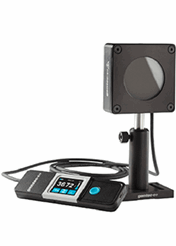Minimum pulse width in laser beam measurement: a common misconception
Tuesday, July 03, 2018
Tuesday, July 03, 2018
This week’s blog post explores the common misconception in laser beam measurement that there is a minimum pulse width specification for a laser energy meter.

Consequently, this idea can make a current or future user (maybe even you?) come to the conclusion that an ultrashort pulse laser must be paired with a special and costly detector. It is therefore more than wise that the experts elaborate more on this subject!
The origin of the misconception appears to be a clash between common sense and experimental evidence. Laser beam measurement is all about thermal sensing, and while common sense (and also experience) teaches you that you can touch a very hot object quickly to avoid injuries, it does not factually explain what happens when an energy meter captures an ultrashort pulse.
What I am getting at, here, is that it is legitimate to assume that a very short exposure time to a heat source will not cause the sensing element to detect its temperature increase.
Allow me to better illustrate this idea through a quick personal story. I’m a simple guy, and I tend to forget my coffee around the office a lot. It is to my annoyance that I always find my coffee back at a rather cold temperature. It is during college that I became very liberal to the idea of microwaving my cold coffee to give it back some oomph.
Ensure you purchase the most optimal solution for your measurement needs with this checklist. Download it now, it's helpful and free!Buyer's checklist for laser power & energy meters
Once I’m done with this culinary prowess, it is only natural for me to take a quick sip of the peppy beverage to estimate its current temperature.
This analogy conceptualizes the origin of the misconception as I interpret it. A quick and incomplete exchange of heat will only cause a weak signal to be generated, may it be coming from your somatosensory system or a Gentec-EO energy meter. But what would happen if I downed my coffee very quickly instead?
This last statement actually is the better picture to conceptualize how an energy meter interacts with an incoming pulse of optical energy. The photons will be either reflected or absorbed (transmission is practically 0%).
The photons being absorbed are of importance here, because they cause the pyroelectric crystal of the energy meter to feel the temperature gradient of this absorptive process, and subsequently generate a voltage through the electrodes thanks to the pyroelectrical effect (a.k.a. pyroelectricity).
And this is where the nuance here comes into play. It does not matter whether the pulse was absorbed by the energy meter in the instant of a femtosecond or a microsecond: in the end, the laser optical pulse is now converted to heat, and this is what generates the voltage that we use for measurement.
In other words, two pulses with equal optical energy but with much different pulse width values will generate the same heat gradient through the pyroelectric crystal, and therefore the same amount of voltage will be generated.
This is valid as long as the pulse width, in the example above, is below the maximum pulse width value of the detector: in this case, the pulse is fully absorbed before the device generates its peak voltage, so there would be no ‘’leftover’’ energy that has not been measured.
Now this implies that there is in fact a maximum pulse width with an energy meter. You can imagine that if the pulse is longer than the rise time of the latter, it will reach its peak voltage before the pulse has been fully absorbed, which will definitely cause weird things to happen. The principal thing you would observe is that the energy appears much lower than what it was expected to be.
To return to the coffee analogy, a quick sip basically causes you to generate a weak signal from the small heat increase you gained from doing so.
This would apply if you took a quick sip of a few femtoseconds for example, but in laser beam measurement, the laser pulse is actually fully converted to heat in the process, may it be in an ultrashort instant of time or a relatively longer millisecond pulse: this is therefore the same thing as downing the coffee in a femtosecond instant instead. This way, you actually feel the total energy contained in the coffee!
To be more specific, the reflected part of the pulse still carries optical energy per se, but the absorbed part is fully converted to heat, and heat equals voltage to us. And voltage is good! It is easy to measure and varies proportionally with heat in this product.
The TL;DR version of this text (or I guess we could say, the conclusion) is that an optical energy pulse coming from a laser source is fully absorbed when it ‘’hits’’ the Gentec-EO detector surface.
There is no such thing as a pulse being too short because in all cases, the optical energy of the pulse is converted to heat, and the energy detector is slow enough to gather all this heat before reaching its peak output voltage. This actually implies, instead, that there is a maximum pulse width with all energy detectors.
Now go get yourself a nice cup of coffee and think: was I wrong all this time? Can I ever trust my common sense again to understand the fundamentals of laser beam measurement?
Thankfully, we can relieve you of any laser beam measurement question you may still have: feel free to contact us for any question and to subscribe to our newsletter below to get more laser beam measurement tips.